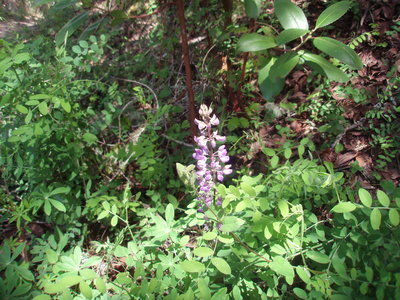
Few things can compare with walking on a scenic woodland trail lined with wildflowers. Now that it’s officially spring, I recently took a hike in Quail Hollow Ranch County Park to see what I could find.
One of the unique aspects of this park is the number of rare plants and animals that make this valley their home. It didn’t take long to find the threatened silver-leafed manzanita, although it wasn’t blooming yet. The sandhill ecosystem where it grows among ponderosa pine is found in Santa Cruz County and nowhere else in the world.
Once upon a time, this land was under water, part of an ancient ocean bed, which uplifted to form the Santa Cruz Mountains about 3 million years ago. According to the Santa Cruz Department of Parks, the silt, sand and mud that had been deposited in that shallow sea turned into the shale, sandstone and mudstone that make up Quail Hollow today.
The diversity of this special place is mirrored in the patchwork of 15 habitats in a small, secluded valley. Mixed evergreen forest, redwoods, grasslands and a pond with its surrounding riparian ecosystem mix with the hot, dry chaparral and sandhill environments. The sandy soils here have eroded from the Santa Margarita sandstone and serve as an aquifer for the San Lorenzo Valley.
Hiking the trails among the blooming mimulus, large-leafed lupine, western hound’s tongue, manzanita and ceanothus made me think about the impact of our own gardens on the populations of native plants like those here.
Are we contaminating the native gene pool if we plant a mimulus, for instance, from southern California, or a hybrid in our own garden?
The genes of all native plants have been sorted out over a very, very long time scale, and they’re finely tuned to their environment. When you introduce an exotic gene — “exotic” meaning not of this place; it could be from as near as a neighboring county — we don’t know the long-term effect that’s going to have.
If you live next to a wild population of a certain plant, such as ceanothus, you should try to plant locally collected and propagated plants and seed. They are harder to find, but local growers do collect seed and identify the source.
On the other hand, ceanothus is a fire-dependent species and does not regenerate from seed, except in the presence of fire or some other disturbance. If in doubt, you could substitute a drought-tolerant Mediterranean shrub that wouldn’t interbreed with local native plants.
Of course, this is probably not a problem for the homeowner who lives in a neighborhood and wants to plant a couple of those cool, new sticky monkey flower hybrids. If they do interbreed with the native population, in time, whatever genetic pollution there is will probably die out. The home gardener is not planting fields of one type of plant that would interfere with the wild population.
There are many philosophies about planting California natives. There is no one-size-fits-all when it comes to this subject. One thing’s for sure: We all want to preserve our wild areas, like Quail Hollow.
Jan Nelson, a landscape designer and California certified nursery professional at Plant Works in Ben Lomond, will answer questions about gardening in the Santa Cruz Mountains. Contact her at ja******@*ol.com or JanNelsonLandscapeDesign.com.










